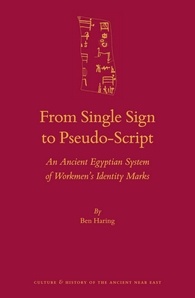 Writing is not the only notation system used in literate societies. Some visual communication systems are very similar to writing, but work differently. Identity marks are typical examples of such systems, and this book presents a particularly well-documented marking system used in Pharaonic Egypt as an exemplary case.
Writing is not the only notation system used in literate societies. Some visual communication systems are very similar to writing, but work differently. Identity marks are typical examples of such systems, and this book presents a particularly well-documented marking system used in Pharaonic Egypt as an exemplary case.
From Single Sign to Pseudo-Script is the first book to fully discuss the nature and development of an ancient marking system, its historical background, and the fascinating story of its decipherment. Chapters on similar systems in other cultures and on semiotic theory help to distinguish between unique and universal features. Written by Egyptologist and SIGNUM member Ben Haring, the book addresses scholars interested in marking systems, writing, literacy, and the semiotics of visual communication.
Copies are available for purchase at Brill publishers.
Table of contents
List of Figures
Prologue
Ancient Egyptian Identity Marks in Theoretical and Comparative Perspective
1 Making Sense of Funny Signs
1.1 An Ancient Text from Berlin
1.2 Documentary Texts, Hieratic and Otherwise
1.3 The Research History of the Necropolis Workmen’s Marks
1.4 A Quick Lesson in Hieroglyphs
1.5 Marks and Hieroglyphs
1.6 The Aim of the Present Book
2 Identity Marks, Egyptian and Other
2.1 A Unique Document
2.2 Ancient Egyptian Pot Marks
2.3 Builders’ Marks, from Teams to Individuals
2.4 Marking Systems Worldwide
2.5 Masons’ Marks in Europe, Medieval and Later
2.6 The Morphology of Masons’ Marks
2.7 Why Were Masons’ Marks Applied?
2.8 Masons and Masters
2.9 Masons’ Marks in Families and Workshops
2.10 General Characteristics of Marking Systems
3 Writing and Other Sign Systems
3.1 Theories of the Sign
3.2 The Sign in Structuralism: Paradigm and Syntagma, Signifier and Signified
3.3 The Sign According to Peirce: Referentiality and Semiosis
3.4 Visual and Material Communication: To Write, or Not to Write?
3.5 Writing and Other Graphic Systems, Independently and Together
3.6 Literacy: Mastering Writing … and Much More
The Deir el-Medina Marking System
4 The Setting: The Workmen of the Royal Tomb and Their Textual Legacy
4.1 An Exceptional Village
4.2 The Early History of the Royal Necropolis and Its Workmen
4.3 Great Changes for Egypt and for the Royal Necropolis
4.4 Ramesside Necropolis Administration, and Administrators
4.5 The End of the Royal Necropolis
4.6 Hieratic Necropolis Records … by the Thousands
4.7 The Nature of the Documentary Texts
4.8 Local Knowledge and Output, Textual and Visual
5 The Use of the Workmen’s Marks: Historical Overview
5.1 The Earliest Marks of the Royal Necropolis Workmen
5.2 The Origin of the Marking System
5.3 A Break in the History of the Marking System?
5.4 Nineteenth-Dynasty Ostraca with Marks
5.5 Marks and Families
5.6 The Function of the Nineteenth-Dynasty Marks
5.7 The Twentieth-Dynasty Duty Rosters
5.8 Other Types of Record from the Twentieth Dynasty
5.9 The Late Twentieth Dynasty
6 How the Men Came by Their Marks, and Vice Versa
6.1 Marks and Their Users
6.2 Long- and Short-Lived Marks: Pomegranate, Lotus and Jackal
6.3 Long-Lived Marks and Their Graphic Variety: The Families of Qaha and Sennedjem
6.4 Short-Lived Marks: Name, Reputation and Status
6.5 Mark, Family and Position
6.6 Morphology: Distinctive Forms versus Allomorphs
6.7 Sign Categories and Fuzzy Borders
6.8 The Role of Writing and Literacy
6.9 Morphology and Semiosis: Anything Goes?
6.10 Historical and Functional Context: Graphic Communication and Literacy
Epilogue: The Alphabet
Bibliographical Essay
References
Timetable
Index